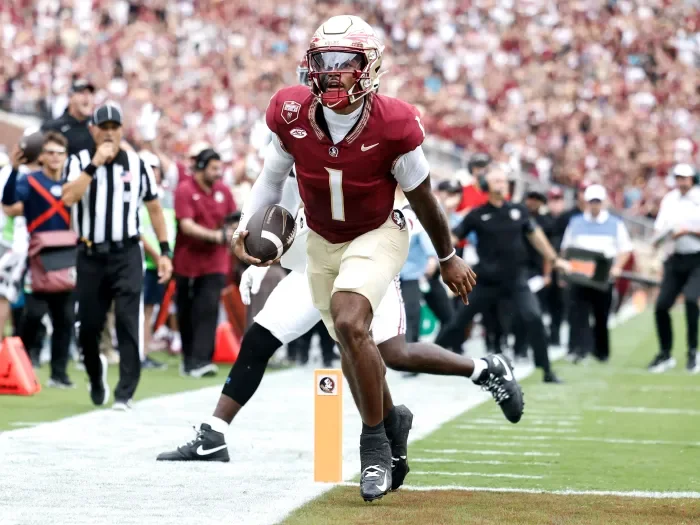Tommy Castellanos, QB vs #8 Alabama 2025
Player: Tommy Castellanos, QB, Florida State
Height: 5’11”
Weight: 201 lbs
Class: Senior
Opponent: #8 Alabama
Year: 2025
Final Stat Line:
9/14, 152 YDS, 0 TD, 0 INT, 0 Sacks
16 CAR, 78 YDS, 1 TD
Film Link: Watch on YouTube
Overview
This was a low-volume, high-leverage showing where Castellanos played a great game of football against an elite front: no panic, no turnovers, and no sacks. The plan leaned on pistol/gun, read-option, and quick play-action to slow Alabama’s second level, then took selective shots when the structure presented them. He created two explosives through the air, finished a red-zone drive with his legs, and managed four quarters without the drive-killing negative plays that usually show up in this matchup.
Mechanically, he’s improved: calmer base, fewer heel clicks, and better sequencing. Velocity is adequate, not special, but he compensates with timing and workable placement. Processing looked steady—eyes stayed up when the pocket squeezed, and he hit his back foot on schedule on the key down-and-distance throws. The outlier is a third-quarter sail where his front shoulder flies open and the ball goes to no one; that’s either a misread of route rules vs rotation or a predetermined throw. Clean that up, and the tape reads efficient operator with package/run value and situational poise.
Film Review - Key Plays
Play 1) 3:34 1Q, 3rd & 11 - 40-yard shot
Alabama rushes four and compresses the interior late. Castellanos maintains a stacked base through a single hitch and releases before contact—hips clear, front shoulder aimed, no fadeaways. The ball lands outside leverage where only his WR has a play; receiver needs a layout, but the decision and timing punish single-high with the corner opened. This is big-boy courage and sequencing on a must-down, and it’s how you steal explosives without forcing hero ball.
Play 2) 3:10 1Q, 1st & Goal - 9-yard Rush TD (read-option keep)
The EMOL crashes; Castellanos keeps to the field. He paces the edge defender with the lead blocker as a moving shield, then uses a short, efficient jump-cut to slip the alley defender. No wasted drift, no ball-exposure at the pylon. It’s not raw speed—it's angles and decisiveness. This is bankable red-zone utility and two-point playbook value.
Play 3) 12:01 2Q, 3rd & 5 - 15-yard in-breaker
Back-foot hits, ball is out—no extra gather. The hook defender widens with the No. 2, and Castellanos drives the in with enough RPM to beat closure. Placement is professional: low/inside to protect the WR from the lurking safety. It’s a routine NFL concept, but the rhythm and trust are the point; he operated on time against a good zone picture and moved the chains.
Play 4) 10:22 3Q, 1st & 10 — 65-yard wheel to RB
Two-back set with PA freezes second level; eyes stay middle just long enough to hold the safety. When the RB stacks the OLB on the wheel, Castellanos resets and adds air, not heat—ball arrives with a friendly trajectory that preserves stride. Yes, there’s coverage bust here, but the timing (trigger at the stack) and touch (layered, not driven) turn a blown coverage into a near house call instead of a 25-yard dink. That’s functional quarterbacking, not luck.
Play 5) 3:29 3Q, 3rd & 4 - sailed incompletion
Clean pocket, feet stall, front shoulder opens early, and the ball sails over the route picture. Either he expected a bend vs zone and got a sit vs man, or he pre-threw a seam vs a rotation that didn’t materialize. This is the one rep that drags the grade: mental/mechanical sync slips, and the ball has no chance. It’s fixable with tighter route-rule communication and a commitment to keep the base alive through the read.
Final Thoughts
Against #8 Alabama, Castellanos looked like an efficient operator with real package/run value. He created explosives without forcing the issue, finished a red-zone drive with his legs, and—most importantly—kept a nasty front from landing a single sack. The lone third-quarter sail keeps it from “surgical,” but the tape reads controlled, composed, and effective.
Strengths on Display
Pocket Poise vs Pressure: Calm feet, on-time decisions, worked through reads without panic.
Negative-Play Avoidance: 0 sacks, no giveaways; kept the offense on schedule.
Red-Zone/Short-Yardage QB Run: Decisive RO keeps, good angle management at the pylon.
PA Sequencing & Selective Shots: Timely 40-yard strike and well-layered wheel off play-action.
Areas for Improvement
Route-Rule/Rotation Sync & Late-Down Mechanics: Eliminate the 3Q sail (no predetermining), keep the base alive so the front shoulder doesn’t fly open.inal Thoughts
